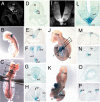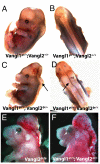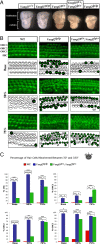Genetic interaction between members of the Vangl family causes neural tube defects in mice
- PMID: 18296642
- PMCID: PMC2265143
- DOI: 10.1073/pnas.0712126105
Genetic interaction between members of the Vangl family causes neural tube defects in mice
Abstract
Neural tube defects (NTDs) are very frequent congenital abnormalities in humans. Recently, we have documented independent association of Vangl1 and Vangl2 gene mutations with NTDs. In the Looptail mouse, homozygosity (but not heterozygosity) for loss-of-function alleles at Vangl2 causes the severe NTD craniorachischisis, whereas heterozygosity for mutant variants of VANGL1 is associated with NTDs in a human cohort of sporadic and familial cases. To understand the role of Vangl1 in normal development, we created a mouse mutant with an inactivating mutation at Vangl1 (Vangl1(gt)). Vangl1 shows a dynamic pattern of expression in the developing neural tube and notochord at the time of neural tube closure. Vangl1(gt/+) heterozygotes and Vangl1(gt/gt) homozygotes are viable and fertile, although Vangl1(gt/gt) display subtle alterations in polarity of inner hair cells of the cochlea. Remarkably, and as opposed to healthy Vangl1(gt/+) and Vangl2(lp/+) heterozygotes, Vangl1(gt/+);Vangl2(lp/+) double heterozygotes show profound developmental defects that include severe craniorachischisis, inner ear defects (disorganization of the stereociliary bundles of hair cells of the organ of Corti), and cardiac abnormality (aberrant right subclavian artery). These results show that genetic interaction between Vangl1 and Vangl2 genes causes neural tube defects and raise the possibility that interaction between individual Vangl genes and other genetic loci and/or environmental factors may additionally contribute to the etiology of NTDs.
Conflict of interest statement
The authors declare no conflict of interest.
Figures






References
-
- Frey L, Hauser WA. Epidemiology of neural tube defects. Epilepsia. 2003;44(Suppl)(3):4–13. - PubMed
-
- Botto LD, Moore CA, Khoury MJ, Erickson JD. Neural-tube defects. N Engl J Med. 1999;341:1509–1519. - PubMed
-
- Kibar Z, Capra V, Gros P. Toward understanding the genetic basis of neural tube defects. Clin Genet. 2007;71:295–310. - PubMed
-
- Finnell RH, Waes JG, Eudy JD, Rosenquist TH. Molecular basis of environmentally induced birth defects. Annu Rev Pharmacol Toxicol. 2002;42:181–208. - PubMed
-
- Copp AJ, Greene ND, Murdoch JN. The genetic basis of mammalian neurulation. Nat Rev Genet. 2003;4:784–793. - PubMed
Publication types
MeSH terms
Substances
Grants and funding
LinkOut - more resources
Full Text Sources
Other Literature Sources
Medical
Molecular Biology Databases
Miscellaneous

